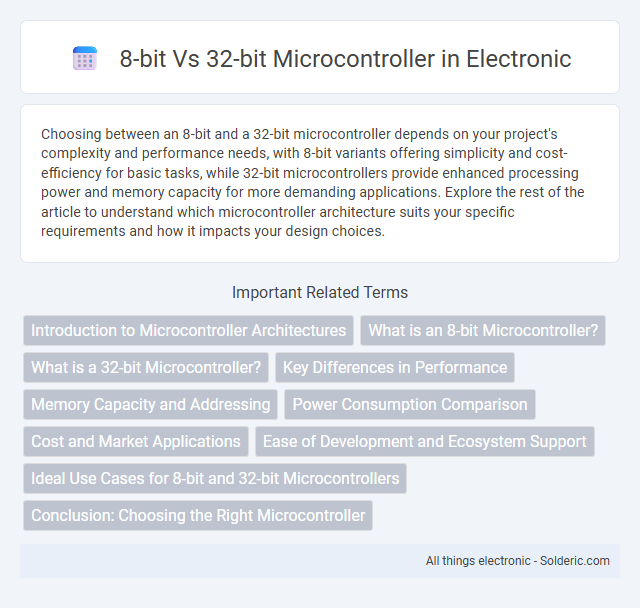Choosing between an 8-bit and a 32-bit microcontroller depends on your project's complexity and performance needs, with 8-bit variants offering simplicity and cost-efficiency for basic tasks, while 32-bit microcontrollers provide enhanced processing power and memory capacity for more demanding applications. Explore the rest of the article to understand which microcontroller architecture suits your specific requirements and how it impacts your design choices.
Comparison Table
| Feature | 8-bit Microcontroller | 32-bit Microcontroller |
|---|---|---|
| Data Bus Width | 8 bits | 32 bits |
| Processing Power | Low to moderate | High |
| Memory Addressing | Up to 64KB | Up to 4GB |
| Instruction Set | Simple, fewer instructions | Complex, extensive instructions |
| Power Consumption | Lower | Higher |
| Cost | Low | Higher |
| Application | Basic control tasks, simple devices | Advanced computing, complex systems |
| Speed | Up to 20 MHz | 100 MHz and above |
Introduction to Microcontroller Architectures
Microcontroller architectures vary significantly between 8-bit and 32-bit designs, impacting processing power, memory capacity, and application complexity. 8-bit microcontrollers typically handle simpler tasks with limited data width, making them ideal for basic embedded systems and low-cost applications. In contrast, 32-bit microcontrollers support advanced features like higher addressable memory, increased computational speed, and are suited for complex systems requiring real-time processing and multitasking.
What is an 8-bit Microcontroller?
An 8-bit microcontroller processes data in 8-bit chunks, meaning its CPU registers, data bus, and ALU are designed to handle 8 bits of data simultaneously. It is commonly used in applications requiring simple control tasks, low memory usage, and cost-effective solutions with limited processing power. Typical examples include devices like ATmega328 and PIC16F877, widely found in embedded systems such as home appliances and basic automation.
What is a 32-bit Microcontroller?
A 32-bit microcontroller processes data and instructions in 32-bit chunks, allowing for greater computational power and memory addressing capabilities compared to 8-bit microcontrollers. It can handle complex applications, support larger data types, and execute more efficient instructions, making it ideal for advanced embedded systems. Your choice of a 32-bit microcontroller enhances performance in tasks requiring higher precision and faster processing speeds.
Key Differences in Performance
8-bit microcontrollers process data in 8-bit chunks, resulting in slower computation speeds and limited memory addressing capabilities compared to 32-bit microcontrollers. 32-bit microcontrollers handle larger data widths and more complex instructions, enabling higher processing power, faster execution, and improved multitasking efficiency. Your choice between 8-bit and 32-bit significantly impacts the performance level required for your application, especially in tasks demanding speed and precision.
Memory Capacity and Addressing
8-bit microcontrollers typically support memory addressing up to 64KB, limiting their ability to handle large data or complex applications. In contrast, 32-bit microcontrollers can address memory sizes in the range of gigabytes, providing significantly greater capacity for program storage and data processing. Your choice between these architectures depends heavily on the memory requirements of your project and the complexity of the tasks involved.
Power Consumption Comparison
8-bit microcontrollers generally consume less power than 32-bit microcontrollers due to their simpler architecture and lower clock speeds, making them ideal for battery-operated and energy-sensitive applications. However, 32-bit microcontrollers offer advanced power management features and dynamic voltage scaling, which can optimize power consumption during complex processing tasks. Your choice should consider the balance between power efficiency and processing requirements based on the specific application.
Cost and Market Applications
8-bit microcontrollers typically offer lower costs due to simpler architectures and reduced memory requirements, making them ideal for budget-sensitive applications such as household appliances, simple sensors, and basic automotive controls. In contrast, 32-bit microcontrollers provide enhanced processing power and greater memory capacity, suiting complex applications including industrial automation, IoT devices, and advanced communication systems, despite their higher price point. Market trends show 8-bit MCUs dominate low-cost, high-volume sectors, while 32-bit MCUs capture growth in performance-intensive and feature-rich product segments.
Ease of Development and Ecosystem Support
8-bit microcontrollers often provide simpler architectures with abundant beginner-friendly development tools and extensive community-driven libraries, making them ideal for straightforward applications and rapid prototyping. In contrast, 32-bit microcontrollers offer advanced development environments, richer peripheral support, and compatibility with sophisticated real-time operating systems, catering to complex and performance-intensive projects. The 32-bit ecosystem benefits from extensive vendor support, comprehensive middleware, and scalable software stacks, facilitating industrial-grade solutions with long-term maintainability.
Ideal Use Cases for 8-bit and 32-bit Microcontrollers
8-bit microcontrollers excel in simple, low-power applications such as basic sensor monitoring, small home appliances, and simple control systems where cost and energy efficiency are critical. 32-bit microcontrollers are ideal for complex tasks requiring higher processing power, including real-time data processing, advanced communication protocols, and applications in automotive, industrial automation, and IoT devices. Your choice depends on the balance between computational needs and resource constraints, with 8-bit suited for minimalistic control and 32-bit for sophisticated, high-performance operations.
Conclusion: Choosing the Right Microcontroller
Selecting the right microcontroller depends on the application's complexity and performance needs; 8-bit microcontrollers offer simplicity, lower power consumption, and cost-effectiveness for basic tasks while 32-bit microcontrollers provide higher processing power, enhanced memory capacity, and advanced peripheral support suitable for demanding applications. Designers should evaluate memory requirements, processing speed, power constraints, and peripheral interfaces to determine the optimal microcontroller architecture. Cost considerations and future scalability also play pivotal roles in making an informed decision between 8-bit and 32-bit microcontrollers.
8-bit vs 32-bit microcontroller Infographic

 solderic.com
solderic.com